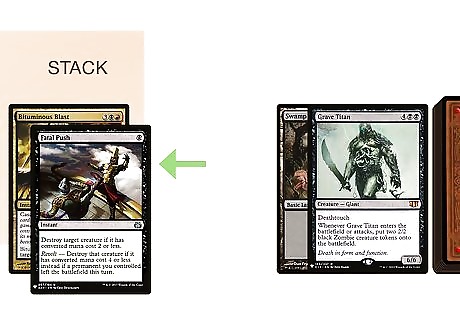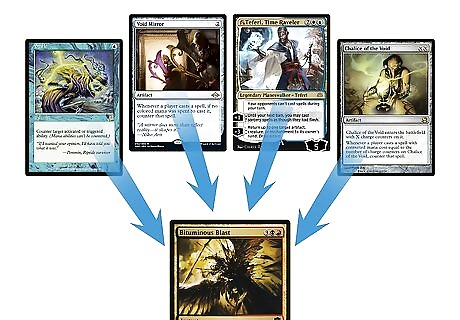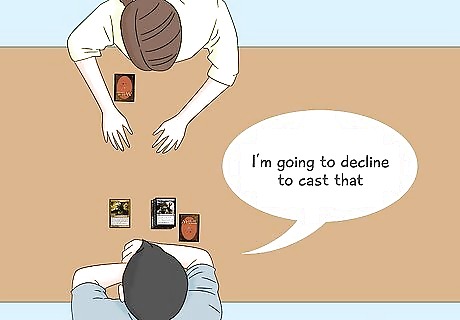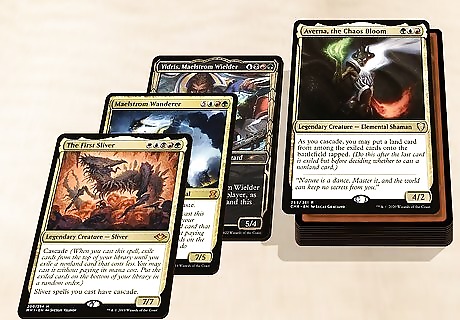
views
- Cascade is a triggered ability that occurs when you cast a card with that keyword.
- To cascade, reveal cards from the top of the library until you reveal a nonland card with a lower CMC.
- The cascading player may cast that nonland card without paying its mana cost.
- Cascade is a powerful ability, especially in conjunction with the suspend cards, (like Living End) since cascade only cares about the CMC.
What is cascade?

Cascade is a powerful triggered ability that lets you cast cards for free. Cascade is a keyword that appears on some creatures and spells. When a card with cascade is cast, the casting player reveals cards from the top of their library until they reveal a nonland card with a lower converted mana cost (CMC) than the cascade card. The casting player may choose to cast the revealed card without paying its mana cost. Unlike static abilities, triggered abilities go on the stack. This means that your opponent has the opportunity to respond to the trigger. Cascade is considered one of the more powerful keywords in the game. You can find a full list of cards featuring cascade, here. Don’t feel like scrolling through all that? We’ll cover the key cards later in the article.
How does cascade work?

A player casts a card with cascade and the spell goes on the stack. Let’s say a player casts Bituminous Blast, targeting an opponent’s creature. Bituminous Blast is a 5 CMC instant that reads, “Bituminous Blast deals 4 damage to target creature.” Bituminous Blast goes on the stack and the other player gets a chance to respond. Smart opponents will normally not respond until the cascade target is revealed, but they do have the opportunity. The stack is where spells and effects go before they resolve (meaning “happen”). The stack is “first in, last out” meaning that when multiple effects are cards are on the stack, the most recent effects and cards resolve first.

That player reveals cards from the top of their deck. With Bituminous Blast on the stack, the casting player begins flipping cards from the top of their library so that both they and their opponent can see the cards. Just FYI, your opponent is allowed to look at all of the revealed cards in detail, if they’d like.

The player stops once they reveal a card with a lower CMC. Let’s say the player reveals a swamp. Cascade says “nonland” card, so they keep revealing cards. Then, they reveal a Grave Titan. It has a CMC of 6 so they keep revealing cards. Next, let’s say the player reveals a Fatal Push. Since Fatal Push has a CMC of 1, which is lower than Bituminous Blast, that player stops revealing cards. To identify CMC, add the total value of the casting cost together. Grave Titan costs 4BB (4 colorless mana and two black mana). Add it together to get a total CMC of 6.

The card with the lower CMC goes on the stack. Remember, Bituminous Blast is still on the stack. The Cascade trigger resolves, and the Fatal Push goes on the stack, on top of the Bituminous Blast. Shuffle the cards you revealed and give your opponent the opportunity to cut the deck if they’d like. Then, put those cards on the bottom of your library.

Both the revealed card and the cascade spell resolve. Fatal Push reads, “Destroy target creature if it has mana value 2 or less.” Since Fatal Push is on the top of the stack, it resolves first. The casting player chooses a target and casts the spell. It resolves (so long as the opponent doesn’t counter it). Then, the Bituminous Blast resolves and hits its initial target. You cannot change the target of a card once it’s selected. So, if the Fatal Push destroys the creature the Bituminous Blast was targeting, you wouldn’t get to choose a new target for the Bituminous Blast.
Notes, Nuances, and Interactions

If you counter a cascade spell, the cascade trigger still resolves. You can 100% counter a card with cascade on it using a card like Counterspell or Logic Knot. However, the cascade trigger would still resolve after the counter. This is part of what makes cascade cards so powerful. It’s hard for opponents to deal with the cascade trigger, so a cascade card is sort of like getting two cards for the cost of one.

You can counter the card selected by the cascade trigger. While countering the cascade card won’t deal with the cascade trigger, you can 100% counter whatever card is revealed by the cascade ability. If you do, the other player still gets the card with cascade on it, but those cards are usually a lot less powerful than whatever the other cards in that player’s deck are. Because the cascade effect is so powerful, the cascade cards on their own are normally a little underpowered.

Only a handful of popular cards can counter cascade triggers. The list of playable, competitive cards that successfully stop cascade triggers from resolving is pretty small. If you find yourself facing a ton of cascade triggers at your local tournaments or in your local playgroups, consider playing or sideboarding: Stifle. While only legal in Legacy and Vintage, Stifle is a great all-around counter for triggers. Even if you don’t run into cascade cards, Stifle can brick the fetchland triggers! Void Mirror. Void Mirror just flat-out counters whatever card is cascaded into. Teferi, Time Raveler. Teferi doesn’t prevent or counter anything, but it keeps your opponent from cascading at instant speed, which is often a huge deal. His minus ability also makes a lot of popular cascade targets easier to deal with. Chalice of the Void. Chalice on zero prevents the suspend cards from being cascaded into, which is often the goal for Modern cascade decks.

You can cascade into other cards with cascade. Cascade only cares if a card has a lower CMC than the card with cascade in it. Notably, cascade specifically says you may “cast” that card for free. At the same time, cascade is a “cast” trigger, meaning that it goes on the stack once you cast the card. Put these two together and you can cascade into cascade into cascade and so on. In other words, if you play an Annoyed Altisaur and cascade into Boarding Party, you’ll cascade a second time.

The cascading player can choose to not cast the cascade target. Cascade specifically says that “you may cast” the card you cascade into. That “may” is a big deal! If you cascade into a removal spell and your opponent has no creatures on the board, you do not have to destroy your own creature. In paper games, just say, “I’m going to decline to cast that” or, “I won’t be playing that” and put the card on the bottom of your library with the other cards you revealed.

The cascaded spell fizzles if it has no legal target or can’t be played. Let’s say you cascade into Eliminate, which says, “Destroy target creature or planeswalker with converted mana cost 3 or less.” But, there’s nothing on the board that costs less than 4! In that case, the Eliminate “fizzles,” meaning it goes to the graveyard without resolving.
Most Iconic Cascade Cards

Bloodbraid Elf Bloodbraid Elf is an iconic card that saw tons of play in Modern Jund, one of the oldest and most consistent midrange decks in the history of the game. At a CMC of 4, Bloodbraid Elf allowed Jund to cascade into basically any card in its deck. Getting to cast a 3/2 with haste and a powerful card like Liliana of the Veil or Tarmogoyf could turn a board state around almost immediately. Bloodbraid Elf doesn’t see much play these days as Jund has mostly become a tighter, more streamlined deck with no room for cards with a CMC of 4. It still pops up every now and then, though!

Shardless Agent First printed in 2012, Shardless Agent immediately became an all-star. In fact, it was powerful enough to immediately generate new Legacy decks that still see play today. At such a low CMC, Shardless Agent allowed players to build their deck in a streamlined way where you knew what you were going to cascade into. If you ever hear a player refer to a deck as “Shardless,” it’s a direct reference to the deck including the card Shardless Agent. There’s Shardless BUG, Shardless Jund, and Shardless aggro. It’s iconic enough to name an entire genre of decks!

Ardent Plea Ardent Plea is just as lowly costed as Shardless Agent (there are no cascade cards that cost less than 3 CMC), and it also gives you the Exalted ability. Exalted allows an attacking creature to get +1/+1 so long as it attacks alone. That’s two huge benefits in one card! It’s also an enchantment, which is rare for cascade cards. Ardent Plea used to see a lot more play than it does today. It still shows up in Glimpse of Tomorrow decks on occasion, though.

Violent Outburst It took a few months for players to catch on, but MTG players eventually realized why Violent Outburst was such an insane card. It’s not a particularly strong effect—giving your creatures +1/+0 for 3 mana is a tough sell—but it does have one major thing going for it. It’s an instant. When you cascade into a card, you get to cast it immediately. This means that you can play Violent Outburst on your opponents turn to get a huge tempo swing. Picture this, you cascade on your opponent’s end step and cascade into a powerful spell. You cast it immediately and then it’s your turn! You get to untap your lands and make even more plays.

Maelstrom Wanderer Maelstrom Wanderer is a very silly card. It’s a massive beater that just allows you to cascade twice. At such a high CMC, it allows you to basically play any card in your deck. This makes it a fun addition to Commander—the format where fun, big silly cards really shine.
Decks that Rely on Cascade

In Modern, Living End and Rhinos rely almost entirely on cascade. The Living End and Rhinos deck are named after two cards, Living End and Crashing Footfalls. You might notice something about those two cards—they don’t have a mana cost! You can only play them using the Suspend mechanic, which is an alternative casting cost. But if you cascade into them, you can play the cards immediately. This is a major combo that basically makes the Living End and Rhinos decks playable. Living End allows you to put your graveyard on the battlefield. To fill the graveyard, it plays a bunch of cycling creatures with massive CMCs. Rhinos is just huge value. Crashing Footfalls puts two 4/4 Rhinos on the board. If you go off on turn 3, which is the goal for most cascade/suspend decks, that’s a tough board for your opponent. Some decks even run both Living End and Crashing Footfalls in the same deck!

In Legacy, Shardless BUG is a popular staple of the format. Shardless BUG (also known as Shardless Sultai) is an interactive midrange deck built around answering whatever problem your opponent creates. It’s named after Shardless Agent, which isn’t so much an engine of the deck as it is a value card. It’s a fixture in the Legacy metagame, mainly because there are so many ways to customize the deck to suit your playstyle.

In Pauper, Gruul Ponza plays a few cascade cards. Pauper is a format built all around value since you can’t play anything that isn’t a common. Gruul Ponza is a red/green deck that plays cards like Mwonvuli Acid-Moss and Thermokarst to destroy their opponents land and win tempo. It only runs a few high-end cascade cards, mainly as mana sinks. Some BG Reanimator decks also run a few cascade cards, but it’s not a hugely common choice

In EDH, there are a few commanders who have cascade. Cascade is a popular EDH mechanic because it’s based on randomness, which makes Commander games more fun. Cascade cards also tend to have high CMCs, which are easier to play in multiplayer games. In order of most to least popular, here are the common commanders with Cascade: Averna, the Chaos Bloom Yidris, Maelstrom Wielder Maelstrom Wanderer The First Sliver



















Comments
0 comment